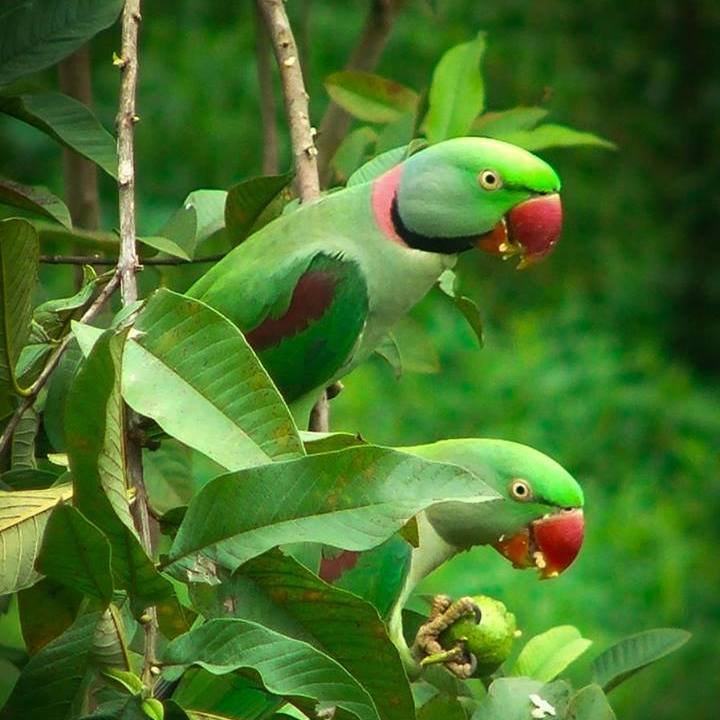
Parrots
Your son Kṛṣṇa appears as an incarnation in every millennium. In the past, He assumed three different colors—white, red and yellow—and now He has appeared in a blackish color. [In another Dvāpara-yuga, He appeared (as Lord Rāmacandra) in the color of śuka, a parrot.] All such incarnations have now assembled in Kṛṣṇa.
(SB 10.8.13)
“You just become guru on My order.” “Then what is Your order, Sir?” Yāre dekha, tāre kaha kṛṣṇa-upadeśa. This is guru. You haven’t got to learn very much. You simply repeat like parrot what Kṛṣṇa has said. That’s all. Is it very difficult? Kṛṣṇa has said everything in the Bhagavad-gītā. You learn Bhagavad-gītā, and you repeat that, you’ll become guru. This is guru.
(750715 – Lecture Arrival – San Francisco)
In Sanskrit language the bird parrot is also known as Suka whose red beaks are impregnated with the quality of enhancing the sweetness of a ripen fruit which is cut by such beaks. Here also the same simile is applied in the matter of the ripen fruit of the Vedic literature referred to above. The Vedic Fruit which is matured and ripen in knowledge is also spoken through the lips of Srila Sukdeva Goswami who is compared with the parrot not for his ability to recite the Bhagwatam exactly in the manner as he heard it from His learned father but because He could present the whole thing in a manner appealing to all classes of men.
(SB 1.1.3)
Actually Śrī Caitanya-caritāmṛta is not my writing but the dictation of Śrī Madana-mohana. My writing is like the repetition of a parrot.
(CC Adi 8.78)
The male parrot sang, “The glorification of Lord Kṛṣṇa, the Supreme Personality of Godhead, is beneficial to everyone in the universe. His beauty is victorious over the gopīs of Vṛndāvana, and it subdues their patience. His pastimes astound the goddess of fortune, and His bodily strength turns Govardhana Hill into a small toy like a ball. His spotless qualities are unlimited, and His behavior satisfies everyone. Lord Kṛṣṇa is attractive to everyone. Oh, may our Lord maintain the whole universe!”After hearing this description of Lord Kṛṣṇa from the male parrot, the female parrot began to recite a description of Śrīmatī Rādhārāṇī. The female parrot said, “Śrīmatī Rādhārāṇī’s affection, Her exquisite beauty and good behavior, Her artistic dancing and chanting and Her poetic compositions are all so attractive that they attract the mind of Kṛṣṇa, who attracts the mind of everyone in the universe.”
(CC Madhya 17.210-17.212)
Simply quoting verses like parrot will not be very much beneficial. One must apply, jñānam vijñāna-sahitam. Jñāna means to know the thing, and vijñāna means to apply the things in practical life. Jñānaṁ vijñāna-sahitam.
(730108 – Lecture NOD – Bombay)
The three sons of Śivānanda Sena, named Caitanya dāsa, Rāmadāsa and Karṇapūra, were all heroic devotees of Lord Caitanya…..
It is stated in the Gaura-gaṇoddeśa-dīpikā (145) that the two famous parrots named Dakṣa and Vicakṣaṇa in kṛṣṇa-līlā became the elder brothers of Kavi-karṇapūra, namely Caitanya dāsa and Rāmadāsa. Karṇapūra, the third son, who was also known as Paramānanda dāsa or Purī dāsa, was initiated by Śrīnātha Paṇḍita, who was a disciple of Śrī Advaita Prabhu. Karṇapūra wrote many books that are important in Vaiṣṇava literature, such as the Ānanda-vṛndāvana-campū, Alaṅkāra-kaustubha, Gaura-gaṇoddeśa-dīpikā and the great epic Caitanya-candrodaya-nāṭaka. He was born in the year 1448 Śakābda (A.D. 1526). He continually wrote books for ten years, from 1488 until 1498.
(CC Adi 10.62)


